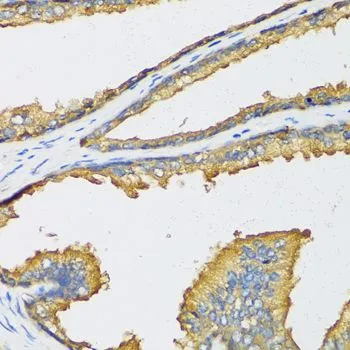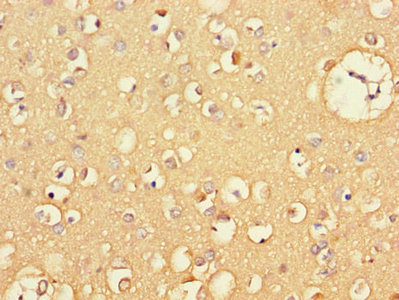
IHC-P analysis of human prostate tissue using GTX53969 CXCL11 antibody. Dilution : 1:100
CXCL11 antibody
GTX53969
ApplicationsImmunoHistoChemistry, ImmunoHistoChemistry Paraffin
Product group Antibodies
TargetCXCL11
Overview
- SupplierGeneTex
- Product NameCXCL11 antibody
- Delivery Days Customer7
- Application Supplier NoteIHC-P: 1:100 - 1:200. *Optimal dilutions/concentrations should be determined by the researcher.Not tested in other applications.
- ApplicationsImmunoHistoChemistry, ImmunoHistoChemistry Paraffin
- CertificationResearch Use Only
- ClonalityPolyclonal
- ConjugateUnconjugated
- Gene ID6373
- Target nameCXCL11
- Target descriptionC-X-C motif chemokine ligand 11
- Target synonymsbeta-R1; b-R1; chemokine (C-X-C motif) ligand 11; C-X-C motif chemokine 11; H174; interferon gamma-inducible protein 9; interferon-inducible T-cell alpha chemoattractant; IP9; IP-9; I-TAC; SCYB11; SCYB9B; small inducible cytokine B11; small inducible cytokine subfamily B (Cys-X-Cys), member 11; small inducible cytokine subfamily B (Cys-X-Cys), member 9B
- HostRabbit
- IsotypeIgG
- Protein IDO14625
- Protein NameC-X-C motif chemokine 11
- Scientific DescriptionChemokines are a group of small (approximately 8 to 14 kD), mostly basic, structurally related molecules that regulate cell trafficking of various types of leukocytes through interactions with a subset of 7-transmembrane, G protein-coupled receptors. Chemokines also play fundamental roles in the development, homeostasis, and function of the immune system, and they have effects on cells of the central nervous system as well as on endothelial cells involved in angiogenesis or angiostasis. Chemokines are divided into 2 major subfamilies, CXC and CC. This antimicrobial gene is a CXC member of the chemokine superfamily. Its encoded protein induces a chemotactic response in activated T-cells and is the dominant ligand for CXC receptor-3. The gene encoding this protein contains 4 exons and at least three polyadenylation signals which might reflect cell-specific regulation of expression. IFN-gamma is a potent inducer of transcription of this gene. Two transcript variants encoding different isoforms have been found for this gene. [provided by RefSeq, Oct 2014]
- Storage Instruction-20°C or -80°C,2°C to 8°C
- UNSPSC12352203

![WB analysis of various samples using GTX04815 CXCL11 antibody [18C54]. Loading : 30 microg Dilution : 1:500](https://www.genetex.com/upload/website/prouct_img/normal/GTX04815/GTX04815_20240419_WB_24041822_894.webp)
![WB analysis of HEK293 expressing human CXCL11 using GTX52663 CXCL11 antibody [9N26].](https://www.genetex.com/upload/website/prouct_img/normal/GTX52663/GTX52663_20191119_WB_w_23060900_653.webp)
![WB analysis of recombinant human ITAC and induced HeLa cell culture supernatant using GTX54750 CXCL11 antibody [10C6] or GTX54751 CXCL11 antibody [22F1] . Dilution : 1:1000](https://www.genetex.com/upload/website/prouct_img/normal/GTX54750/GTX54750_1888_WB_w_23060900_304.webp)

